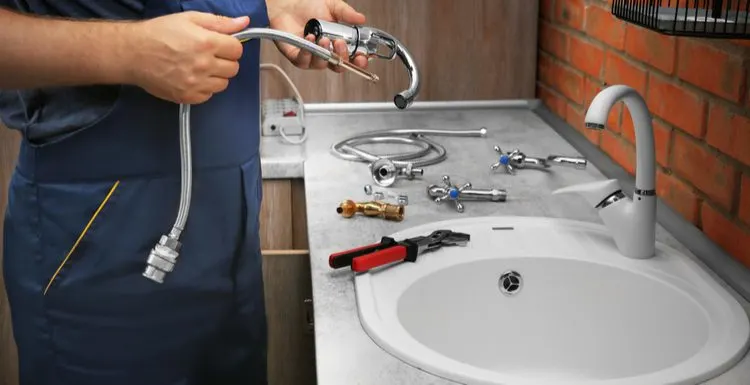In college, we worked in the plumbing section at Menards, where we acquired expertise in faucets, sinks, and the diverse range of products we sold.
You can trust our comprehensive guide, which is unparalleled on the internet.
In this article, we will teach you about the essential components that constitute any sink, as well as the distinctions that may exist among different sink types.
We’ll also talk about some things you may want to consider before you buy, and answer some common questions regarding the parts of a sink.
The three main parts that make up any sink are the faucet, the basin, and the drain. These three major components are each made of smaller parts, and certain sinks may have additional specialty parts.
What Are the Parts of a Sink?
Depending on the location and purpose of a sink, it can have a variety of parts. While all sinks have at least a faucet, basin, and drain, these come in a range of shapes, sizes, and forms.
Kitchen sinks and bathroom sinks naturally include different features and functions, because they serve different purposes.
Commercial and residential sinks also operate differently, and will often be made with different parts.
1. Faucet
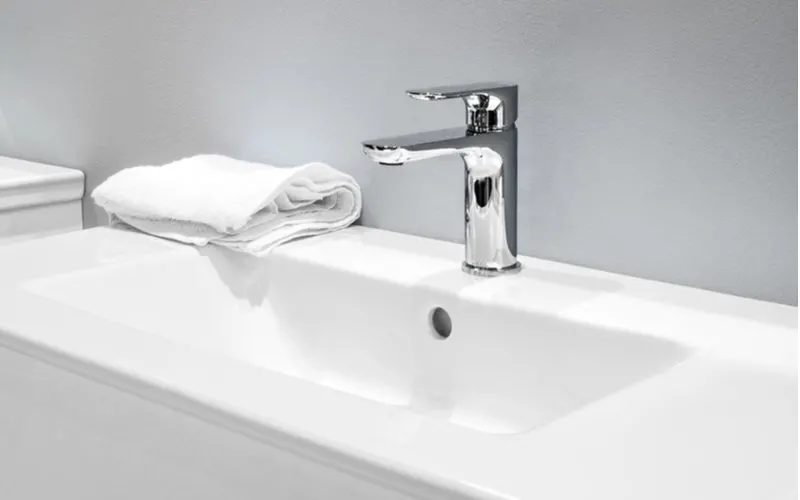
Mateev Alleksandr/Shutterstock
The faucet is the part of the sink where the water comes out and flows into the basin. The running water inside your home connects to the faucet body via hot and cold water supply lines.
Inside the faucet body is a valve that controls the flow of hot and cold water to the spout of the faucet. This valve adjusts the amount of hot and cold water released at one time to adjust the temperature of the water that comes out of the faucet.
The valve is controlled by a single handle or pair of handles, which you use to turn on the water and adjust the temperature and rate of flow. When you turn the handle or handles, the valve responds to adjust the speed of the water and the ratio of hot water to cold water.
Depending on the type of faucet, the hot and cold water may combine in the body of the faucet or in a bridge pipe between separate hot and cold valves. The combined hot and cold water then flows into the basin through the spout.
The spout is the part most people think of when they visualize a faucet because it’s the most obvious part of the fixture. It also comes in the widest variety of configurations.
Kitchen sinks often feature a gooseneck spout that makes it easy to fill deep pots inside the sink. Bathroom sinks typically have lower-profile spouts to avoid spraying water all over the bathroom.
Depending on the intended use of your sink, convenience features are available as well. Some spouts have retractable sprayers and touchless activation for added convenience.
Materials
Brass is the most popular material for sink faucets, mainly because it’s easy to manufacture and durable.
Many faucets that look like stainless steel are actually brass with a stainless steel finish. Solid stainless steel faucets are also available, but they’re much more expensive.
Plastic and zinc faucets are light and inexpensive, but they are also the least durable options. They’re often molded and finished to look like higher-end materials, but the difference is apparent when you touch them.
2. Basin
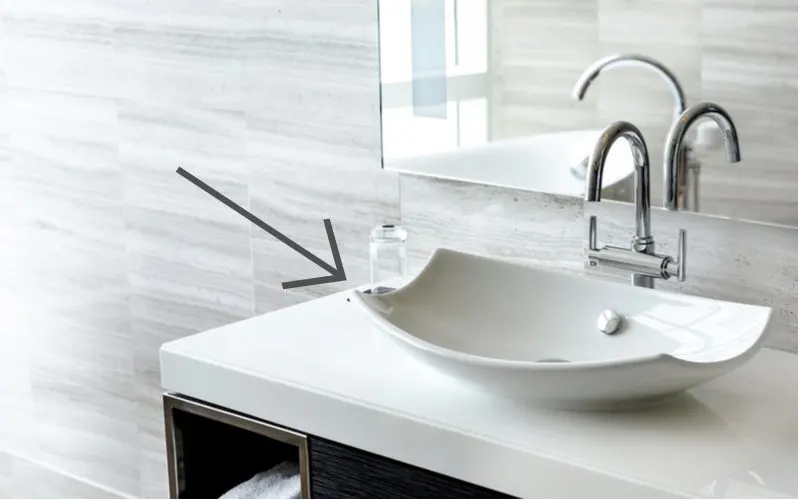
pirke/Shutterstock
The basin is the most visible part of the sink, where the water from the faucet collects. Sinks are often categorized by the type of basin they use and the way they’re mounted.
Countertop sinks are installed into or on top of a counter. They’re common in kitchens and bathrooms alike, in commercial and residential settings. They provide storage and a usable surface in addition to the sink itself.
An integrated sink has a one-piece counter and basin design. The basin can also be a separate piece that sits on top of the counter (vessel sinks), under the countertop (under-mount sinks), or dropped into an opening on the countertop (drop-in sinks).
Console and pedestal sinks have basins that sit on a pedestal or on a freestanding table. The basin and faucet can also be mounted directly to the wall (wall-mount sinks), with the drain and plumbing exposed below or hidden in the wall.
Most bathroom sink basins feature an overflow drain near the top of the basin. This feature allows water that gets above a certain level to escape without overflowing onto the floor.
Materials
You can find sink basins in a wide variety of materials. Stone sink basins look luxurious but are porous and can stain easily, making them inconvenient for use in a lot of settings.
Ceramic is a common sink basin material because it’s durable and easy to clean. So are solid surface sinks, which look like natural stone but are actually manufactured from composite material.
Tempered glass vessel basins are surprisingly durable and can stand up to everyday use, but they can be scratched by kitchen utensils, so they tend to do best in a bathroom. Cast iron, stainless steel, and even copper sink basins are available.
3. Drain
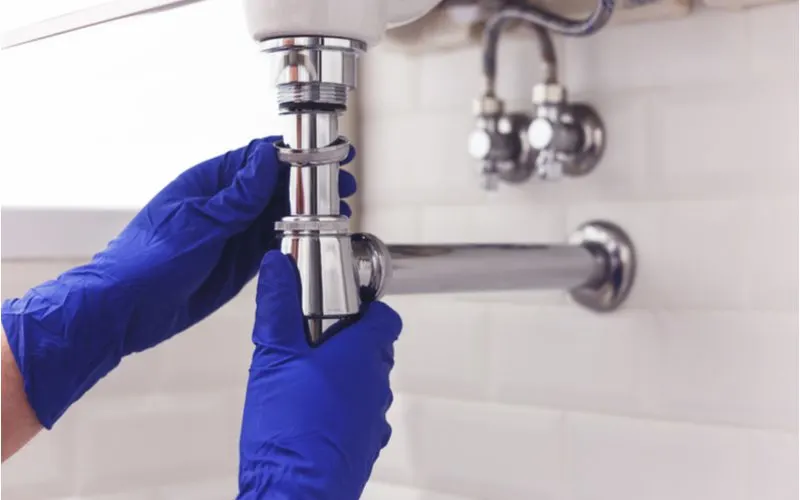
Vladeep/Shutterstock
The drain is the opening at the bottom of the basin that acts as a valve. It can be plugged to keep water in the basin or opened to allow water to flow out.
Bathroom sinks include a stopper that sits inside the drain. Most bathroom drain stoppers aren’t removable and are operated using a pivot rod that connects to a lever in the faucet.
The drain will often be fitted with a removable strainer flange and strainer basket in a kitchen sink. The strainer basket sits inside the drain to prevent food and other waste particles from going down the drain and clogging the plumbing.
Many kitchen sinks include a garbage disposal, which connects below the strainer flange. The garbage disposal uses a set of spinning metal teeth to break up food waste so that it’s small enough to fit through the drain.
Below the strainer assembly or garbage disposal, if there is one, is the tailpiece that connects the drain to the plumbing. A two-piece pipe assembly called a P-trap has a deep bend to prevent clogs and a clean-out plug for when they do occur.
Things to Consider
The most important thing to consider before buying any sink is its purpose. To some extent, this will be determined by the room it’s in.
However, beyond that, you want to make sure your sink includes features that work for your needs. You’ll want to consider details like:
- Durability of materials
- Ease of cleaning
- Convenience features (e.g., touchless operation, sprayer, etc.)
- Style
- Cost
For example, you may opt for a stylish but difficult-to-clean glass vessel sink for a bathroom that’s only used by the occasional visiting guest.
On the other hand, a heavily used kitchen sink should have a durable, easy-to-clean basin with a gooseneck spout and sprayer for convenience.
Frequently Asked Questions
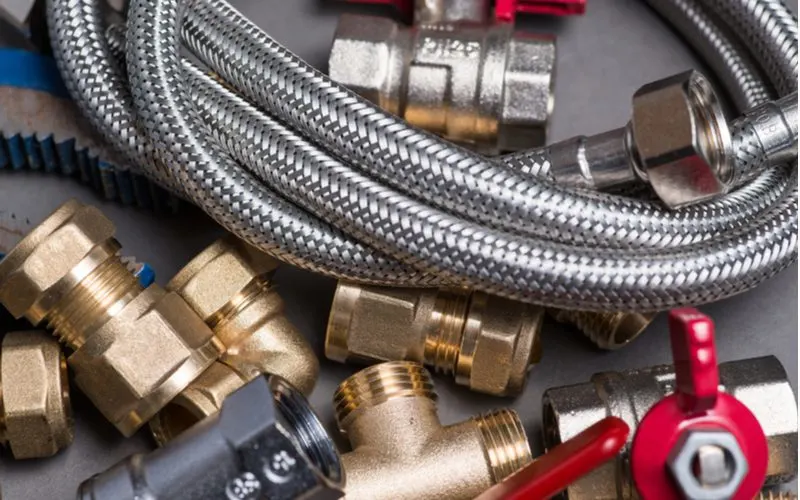
Room 76/Shutterstock
Now that you understand the essential parts of a sink and how they work, here are some common questions about sinks.
What foods can’t go down the garbage disposal?
A garbage disposal is a beneficial feature when it comes to washing your dishes. The disposal helps to break down stray food waste into pieces small enough to go through the pipes without causing a clog.
But there are some types of food waste that you should keep out of your disposal as much as possible. Eggshells and fruit and vegetable peels can accumulate in your pipes over time and cause clogs.
Starchy foods like rice and potatoes can break down at your disposal to a sticky mush that acts like glue in your pipes. But the worst culprits are fats, oils, and greases, which can congeal into fatty clogs further down the municipal water system.
What is the flat part of the faucet mount called?
The escutcheon is the flat metal piece that sits at the base of a faucet. This piece covers the holes in your sink, counter, or wall that connect your faucet and handle(s) to your pipes.
The holes in sinks can be 4 inches apart, or anywhere from 8 to 16 inches apart. Some have multiple holes to allow for different types of faucet installations. The escutcheon covers all the holes, whether your fixture used them or not, to leave a nice, finished look.
Can you replace just the sprayer/faucet/basin of a kitchen sink?
In most cases, the parts of a sink are entirely interchangeable. This means that if your kitchen sink sprayer stops working, or you simply want an upgrade, you can switch that part out while leaving the faucet, basin, and drain intact.
The same goes for the faucet, which is usually a relatively easy fixture to uninstall and replace, even for novice plumbers. Replacing individual parts of your sink can be an affordable way to update the look of a kitchen or bathroom.
Depending on the sink’s installation, even the basin may be replaceable, although this is often more labor-intensive. Matching the type of installation (under-mount, drop-in, vessel) can make it easier, but replacing the basin usually means replacing the whole sink.
Major Parts of a Sink Resume
While the basic parts of a sink and its components are always the same (the basin, the faucet, and the drain), there is a wide range of options available to make a sink work for your needs.
Choosing the sink that’s best suited to your needs will ensure you love it for years to come.

